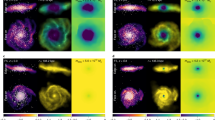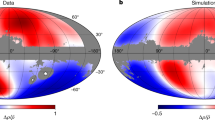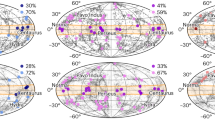Abstract
Magnetic fields are of critical importance for our understanding of the origin and long-term evolution of the Milky Way. This is due to their decisive role in the dynamical evolution of the interstellar medium and their influence on the star-formation process1,2,3. Faraday rotation measures along many different sightlines across the Galaxy are a primary means to infer the magnetic field topology and strength from observations4,5,6,7. However, the interpretation of the data has been hampered by the failure of previous attempts to explain the observations in theoretical models and to synthesize a realistic multiscale all-sky rotation measures map8,9,10. We here utilize a cosmological magnetohydrodynamic simulation of the formation of the Milky Way, augment it with a new star-cluster population-synthesis model for a more realistic structure of the local interstellar medium11,12, and perform detailed polarized radiative transfer calculations on the resulting model13. This yields an accurate first-principles prediction of the Faraday sky as observed on Earth. The results reproduce the observations of the Galaxy not only on global scales but also on local scales of individual star-forming clouds. They also indicate that the Local Bubble14 containing our Sun dominates the rotation measures signal over large regions of the sky. Modern cosmological magnetohydrodynamic simulations of the Milky Way’s formation, combined with a plausible model for star formation, stellar feedback and the distribution of free electrons in the interstellar medium, explain the rotation measures observations remarkably well, and thus contribute to a better understanding of the origin of magnetic fields in our Galaxy.
This is a preview of subscription content, access via your institution
Access options
Access Nature and 54 other Nature Portfolio journals
Get Nature+, our best-value online-access subscription
$29.99 / 30 days
cancel any time
Subscribe to this journal
Receive 12 digital issues and online access to articles
$119.00 per year
only $9.92 per issue
Buy this article
- Purchase on Springer Link
- Instant access to full article PDF
Prices may be subject to local taxes which are calculated during checkout



Similar content being viewed by others
Data availability
No data available.
Code availability
Cluster properties and ionization are calculated with the WARPFIELD code11,42 and the spectral synthesis code CLOUDY v.17.00 (http://www.nublado.org/), respectively. Cosmological simulations are performed by the moving mesh code AREPO30 (https://arepo-code.org/wp-content/userguide/index.html) and for the radiative transfer postprocessing we use the radiative transfer code POLARIS25 (https://portia.astrophysik.uni-kiel.de/polaris/). We used Python and its associated libraries including Astropy, NumPy and Matplotlib for data analysis and presentation.
References
McKee, C. F. & Ostriker, E. C. Theory of star formation. Annu. Rev. Astron. Astrophys. 45, 565–687 (2007).
Heiles, C. & Haverkorn, M. Magnetic fields in the multiphase interstellar medium. Space Sci. Rev. 166, 293 (2012).
Beck, R. Magnetic fields in spiral galaxies. Astron. Astrophys. Rev. 24, 4 (2015).
Morris, D. & Berge, G. L. Direction of the galactic magnetic field in the vicinity of the Sun. Astrophys. J. 139, 1388 (1964).
Oppermann, N. et al. An improved map of the galactic Faraday sky. Astron. Astrophys. 542, A93 (2012).
Sun, X. H. et al. Faraday tomography of the North Polar Spur: constraints on the distance to the Spur and on the magnetic field of the Galaxy. Astrophys. J. 811, 40 (2015).
Hutschenreuter, S. et al. The Galactic Faraday rotation sky 2020. Astron. Astrophys. 657, A43 (2022).
Beck, M. C. et al. New constraints on modelling the random magnetic field of the MW. J. Cosmol. Astropart. Phys. 5, 056 (2016).
Butsky, I., Zrake, J., Kim, J.-h, Yang, H.-I. & Abel, T. Ab initio simulations of a supernova-driven galactic dynamo in an isolated disk galaxy. Astrophys. J. Lett. 843, 113 (2017).
Pakmor, R. et al. Faraday rotation maps of disc galaxies. Mon. Not. R. Astron. Soc. 481, 4410–4418 (2018).
Rahner, D., Pellegrini, E. W., Glover, SimonC. O. & Klessen, R. S. Winds and radiation in unison: a new semi-analytic feedback model for cloud dissolution. Mon. Not. R. Astron. Soc. 470, 4453 (2017).
Pellegrini, E. W. et al. WARPFIELD population synthesis: the physics of (extra-)Galactic star formation and feedback-driven cloud structure and emission from sub-to-kpc scales. Mon. Not. R. Astron. Soc. 498, 3193–3214 (2020).
Brauer, R., Wolf, S., Reissl, S. & Ober, F. Magnetic fields in molecular clouds: limitations of the analysis of Zeeman observations. Astron. Astrophys. 601, A90 (2017).
Zucker, C. et al. Star formation near the Sun is driven by expansion of the Local Bubble. Nature 601, 334–337 (2022).
Klessen, R. S. and Glover, S. C. O. in Star Formation in Galaxy Evolution: Connecting Numerical Models to Reality (eds Revaz, Y. et al.) 85 (Springer-Verlag, 2016).
Andersson, B.-G., Lazarian, A. & Vaillancourt, J. E. Interstellar dust grain alignment. Annu. Rev. Astron. Astrophys. 53, 501–539 (2015).
Planck Collaboration. Planck intermediate results. XXXV. Probing the role of the magnetic field in the formation of structure in molecular clouds. Astron. Astrophys. 586, A138 (2016).
Lazarian, A., Yuen, K. H., Lee, H. & Cho, J. Synchrotron intensity gradients as tracers of interstellar magnetic fields. Astrophys. J. 842, 30 (2017).
Reissl, S., Brauer, R., Klessen, R. S. & Pellegrini, E. W. Radiative transfer with POLARIS. II.: modeling of synthetic galactic synchrotron observations. Astrophys. J. 885, 15 (2019).
Crutcher, R. M. Magnetic fields in molecular clouds: observations confront theory. Astrophys. J. 520, 706 (1999).
Rybicki, G. B. & Lightman, A. P. Radiative Processes in Astrophysics (John Wiley & Sons, 1991).
Pakmor, R., Marinacci, F. & Springel, V. Magnetic fields in cosmological simulations of disk galaxies. Astrophys. J. Lett. 783, L20 (2014).
Grand, R. J. J. et al. The Auriga Project: the properties and formation mechanisms of disc galaxies across cosmic time. Mon. Not. R. Astron. Soc. 467, 179 (2017).
Pellegrini, E. W. et al. WARPFIELD-EMP: the self-consistent prediction of emission lines from evolving H II regions in dense molecular clouds. Mon. Not. R. Astron. Soc. 496, 339–363 (2020).
Reissl, S., Wolf, S. & Brauer, R. Radiative transfer with POLARIS. I.: analysis of magnetic fields through synthetic dust continuum polarization measurements. Astron. Astrophys. 593, A87 (2016).
Burn, B. J. On the depolarization of discrete radio sources by Faraday dispersion. Mon. Not. R. Astron. Soc. 133, 67 (1966).
Alves, M. I. R., Boulanger, F., Ferrière, K. & Montier, L. The Local Bubble: a magnetic veil to our Galaxy. Astron. Astrophys. 611, L5 (2018).
Shanahan, R. et al. Strong excess Faraday rotation on the inside of the Sagittarius Spiral Arm. Astrophys. J. Lett. 887, L7 (2019).
Mao, S. A. et al. Detection of microgauss coherent magnetic fields in a galaxy five billion years ago. Nat. Astron. 1, 621 (2017).
Springel, V. E pur si muove: Galilean-invariant cosmological hydrodynamical simulations on a moving mesh. Mon. Not. R. Astron. Soc. 401, 791 (2010).
Pakmor, R. üdiger et al. Magnetic field formation in the Milky Way like disc galaxies of the Auriga project. Mon. Not. R. Astron. Soc. 469, 3185–3199 (2017).
Rieder, M. & Teyssier, R. A small-scale dynamo in feedback-dominated galaxies as the origin of cosmic magnetic fields - I. The kinematic phase. Mon. Not. R. Astron. Soc. 457, 1722 (2016).
Rieder, M. & Teyssier, R. A small-scale dynamo in feedback-dominated galaxies - II. The saturation phase and the final magnetic configuration. Mon. Not. R. Astron. Soc. 471, 2674–2686 (2017).
Pillepich, A. et al. Simulating galaxy formation with the IllustrisTNG model. Mon. Not. R. Astron. Soc. 473, 4077–4106 (2018).
Hopkins, P. F. et al. But what about…: cosmic rays, magnetic fields, conduction, and viscosity in galaxy formation. Mon. Not. R. Astron. Soc. 492, 3465–3498 (2020).
Ponnada, S. B. et al. Magnetic fields on FIRE: comparing B-fields in the multiphase ISM and CGM of simulated L* galaxies to observations. Mon. Not. R. Astron. Soc. 516, 4417–4431 (2022).
Ferrière, K. M. The interstellar environment of our galaxy. RvMP 73, 1031 (2001).
Schober, J., Schleicher, D., Federrath, C., Klessen, R. & Banerjee, R. Magnetic field amplification by small-scale dynamo action: dependence on turbulence models and Reynolds and Prandtl numbers. Phys. Rev. E 85, 026303 (2012).
Kolmogorov, A. The local structure of turbulence in incompressible viscous fluid for very large Reynolds’ numbers. Dokl. Akad. Nauk SSSR 30, 301–305 (1941).
Brandenburg, A. & Subramanian, K. Astrophysical magnetic fields and nonlinear dynamo theory. Phys. Rep. 417, 1–209 (2005).
Federrath, C. et al. Mach number dependence of turbulent magnetic field amplification: solenoidal versus compressive flows. Phys. Rev. Lett. 107, 114504 (2011).
Rahner, D., Pellegrini, E. W., Glover, SimonC. O. & Klessen, R. S. WARPFIELD 2.0: feedback-regulated minimum star formation efficiencies of giant molecular clouds. Mon. Not. R. Astron. Soc. 483, 2547–2560 (2019).
Kennicutt, R. C. Star formation in galaxies along the Hubble sequence. Annu. Rev. Astron. Astrophys. 36, 189 (1998).
Krumholz, M. R., McKee, C. F. & Bland-Hawthorn, J. Star clusters across cosmic time. Annu. Rev. Astron. Astrophys. 57, 227–303 (2019).
Ferland, G. J. et al. The 2017 release Cloudy. Rev. Mex. Astron. Astrofis. 53, 385 (2017).
Cordes, J. M. and Lazio, T. J. W. NE2001.I. A new model for the Galactic distribution of free electrons and its fluctuations. Preprint at https://doi.org/10.48550/arXiv.astro-ph/0207156 (2002).
Yao, J. M., Manchester, R. N. & Wang, N. A new electron-density model for estimation of pulsar and FRB distances. Astrophys. J. 835, 29 (2017).
Reissl, S. et al. Magnetic fields in star-forming systems (I): idealized synthetic signatures of dust polarization and Zeeman splitting in filaments. Mon. Not. R. Astron. Soc. 481, 2507 (2018).
Hutschenreuter, S. & Enßlin, T. A. The Galactic Faraday depth sky revisited. Astron. Astrophys. 633, A150 (2020).
Acknowledgements
S.R., R.S.K., E.W.P. and D.R. acknowledge support from the Deutsche Forschungsgemeinschaft in the Collaborative Research Center (SFB 881, ID 138713538) ‘The Milky Way System’ (subprojects A1, B1, B2 and B8) and from the Heidelberg Cluster of Excellence (EXC 2181, ID 390900948) ‘STRUCTURES: A unifying approach to emergent phenomena in the physical world, mathematics, and complex data’, funded by the German Excellence Strategy. R.S.K. also expresses thanks for funding from the European Research Council in the ERC Synergy Grant ‘ECOGAL – Understanding our Galactic ecosystem: From the disk of the Milky Way to the formation sites of stars and planets’ (ID 855130). R.G. acknowledges support from an STFC Ernest Rutherford Fellowship (ST/W003643/1). F.A.G. acknowledges support from ANID FONDECYT Regular 1211370, the Max Planck Society through a Partner Group grant and ANID Basal Project FB210003. The project benefited from computing resources provided by the State of Baden-Württemberg through bwHPC and DFG through grant INST 35/1134-1 FUGG, and from the data storage facility SDS@hd supported through grant INST 35/1314-1 FUGG. The Heidelberg team also express thanks for computing time provided by the Leibniz Computing Center (LRZ) for project pr74nu.
Author information
Authors and Affiliations
Contributions
S.R. has run all polarized radiative transfer calculations and has performed most of the analysis. The text was jointly written by S.R. and R.S.K. The WARPFIELD cloud-cluster evolution model was mostly contributed by E.W.P. and D.R. The Augiga-6 data and support with the data handling have been provided by R.P., R.G., F.G., F.M. and V.S.
Corresponding author
Ethics declarations
Competing interests
The authors declare no competing interests.
Peer review
Peer review information
Nature Astronomy thanks the anonymous reviewers for their contribution to the peer review of this work.
Additional information
Publisher’s note Springer Nature remains neutral with regard to jurisdictional claims in published maps and institutional affiliations.
Rights and permissions
Springer Nature or its licensor (e.g. a society or other partner) holds exclusive rights to this article under a publishing agreement with the author(s) or other rightsholder(s); author self-archiving of the accepted manuscript version of this article is solely governed by the terms of such publishing agreement and applicable law.
About this article
Cite this article
Reissl, S., Klessen, R.S., Pellegrini, E.W. et al. A reproduction of the Milky Way’s Faraday rotation measure map in galaxy simulations from global to local scales. Nat Astron 7, 1295–1300 (2023). https://doi.org/10.1038/s41550-023-02053-2
Received:
Accepted:
Published:
Issue Date:
DOI: https://doi.org/10.1038/s41550-023-02053-2



